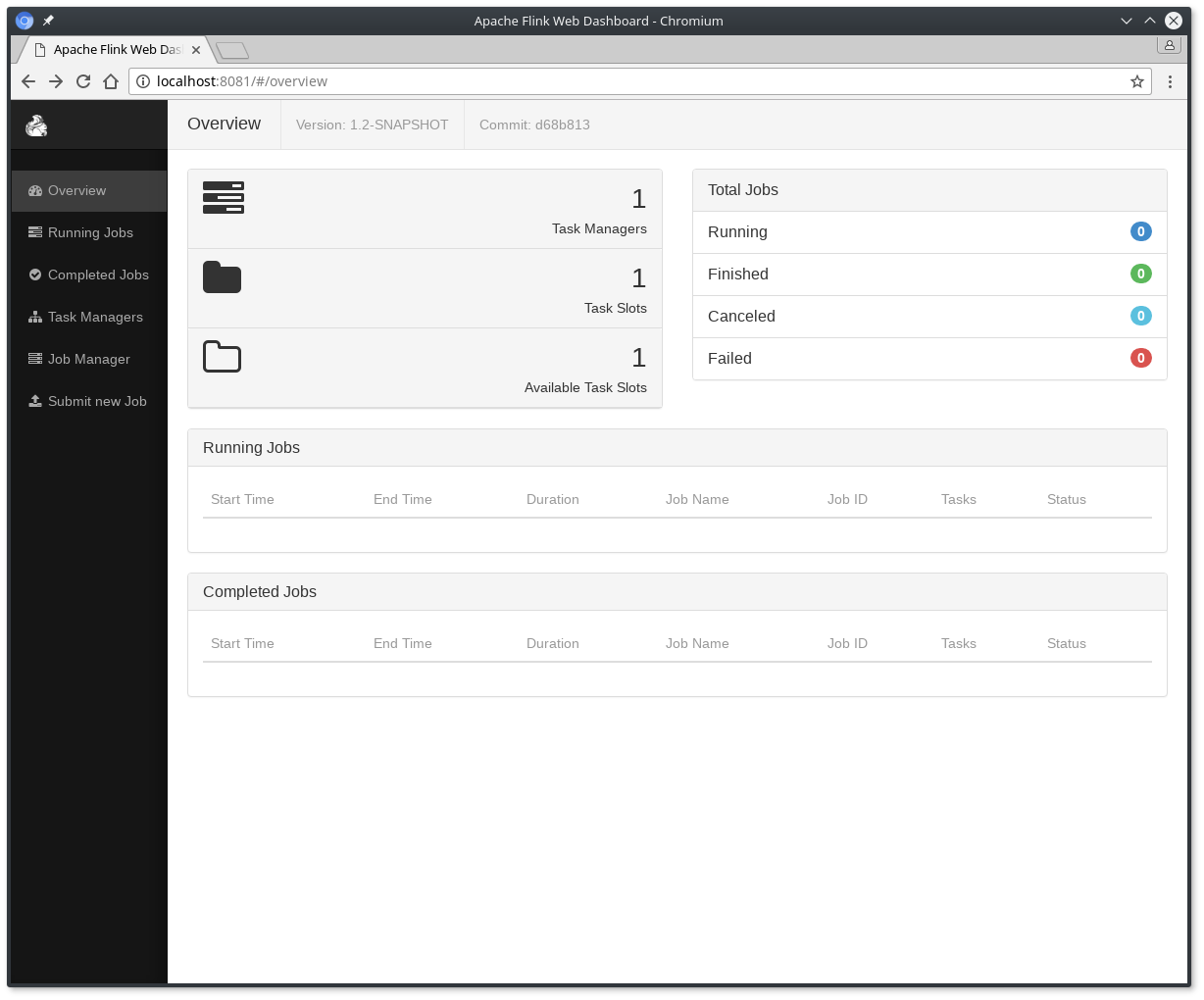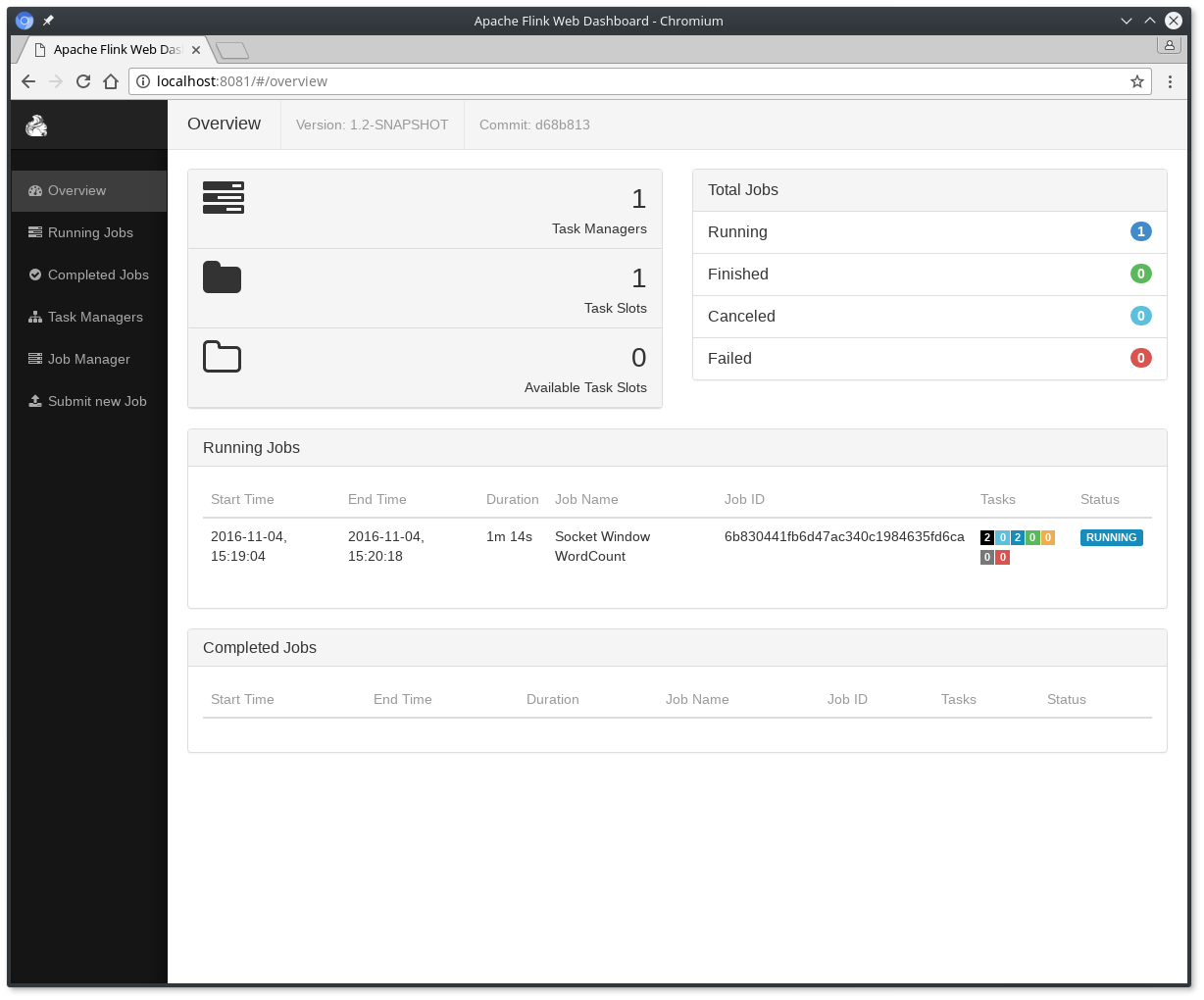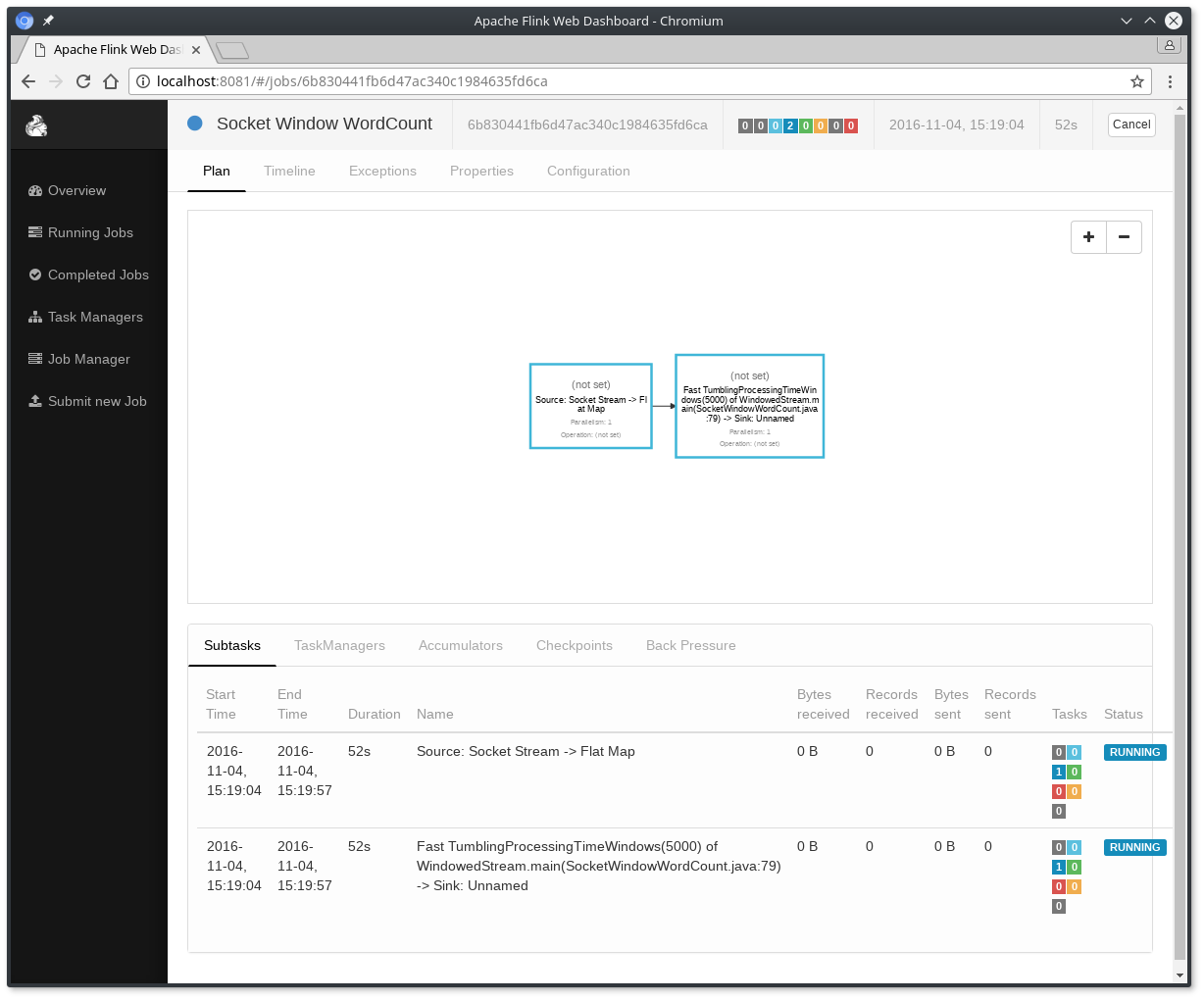本地化部署教程
通过一些简单的步骤运行一个Flink的例子
Setup: Download and Start Flink
Flink runs on Linux, Mac OS X, and Windows. To be able to run Flink, the only requirement is to have a working Java 8.x installation. Windows users, please take a look at the Flink on Windows guide which describes how to run Flink on Windows for local setups.
You can check the correct installation of Java by issuing the following command:
java -versionIf you have Java 8, the output will look something like this:
java version "1.8.0_111"
Java(TM) SE Runtime Environment (build 1.8.0_111-b14)
Java HotSpot(TM) 64-Bit Server VM (build 25.111-b14, mixed mode)- Download a binary from the downloads page. You can pick any Hadoop/Scala combination you like. If you plan to just use the local file system, any Hadoop version will work fine.
- Go to the download directory.
- Unpack the downloaded archive.
$ cd ~/Downloads # Go to download directory
$ tar xzf flink-*.tgz # Unpack the downloaded archive
$ cd flink-1.8.0For MacOS X users, Flink can be installed through Homebrew.
$ brew install apache-flink
...
$ flink --version
Version: 1.2.0, Commit ID: 1c659cfStart a Local Flink Cluster
$ ./bin/start-cluster.sh # Start Flink通过浏览器打开这个地址: http://localhost:8081 and make sure everything is up and running. The web frontend should report a single available TaskManager instance.
You can also verify that the system is running by checking the log files in the logs directory:
$ tail log/flink-*-standalonesession-*.log
INFO ... - Rest endpoint listening at localhost:8081
INFO ... - http://localhost:8081 was granted leadership ...
INFO ... - Web frontend listening at http://localhost:8081.
INFO ... - Starting RPC endpoint for StandaloneResourceManager at akka://flink/user/resourcemanager .
INFO ... - Starting RPC endpoint for StandaloneDispatcher at akka://flink/user/dispatcher .
INFO ... - ResourceManager akka.tcp://flink@localhost:6123/user/resourcemanager was granted leadership ...
INFO ... - Starting the SlotManager.
INFO ... - Dispatcher akka.tcp://flink@localhost:6123/user/dispatcher was granted leadership ...
INFO ... - Recovering all persisted jobs.
INFO ... - Registering TaskManager ... under ... at the SlotManager.Read the Code
You can find the complete source code for this SocketWindowWordCount example in scala and java on GitHub.
object SocketWindowWordCount {
def main(args: Array[String]) : Unit = {
// the port to connect to
val port: Int = try {
ParameterTool.fromArgs(args).getInt("port")
} catch {
case e: Exception => {
System.err.println("No port specified. Please run 'SocketWindowWordCount --port <port>'")
return
}
}
// get the execution environment
val env: StreamExecutionEnvironment = StreamExecutionEnvironment.getExecutionEnvironment
// get input data by connecting to the socket
val text = env.socketTextStream("localhost", port, '\n')
// parse the data, group it, window it, and aggregate the counts
// 分析数据,拆分、分组、时间窗口、汇总
val windowCounts = text
.flatMap { w => w.split("\\s") }
.map { w => WordWithCount(w, 1) }
.keyBy("word")
.timeWindow(Time.seconds(5), Time.seconds(1))
.sum("count")
// print the results with a single thread, rather than in parallel
windowCounts.print().setParallelism(1)
env.execute("Socket Window WordCount")
}
// Data type for words with count
case class WordWithCount(word: String, count: Long)
}public class SocketWindowWordCount {
public static void main(String[] args) throws Exception {
// the port to connect to
final int port;
try {
final ParameterTool params = ParameterTool.fromArgs(args);
port = params.getInt("port");
} catch (Exception e) {
System.err.println("No port specified. Please run 'SocketWindowWordCount --port <port>'");
return;
}
// get the execution environment
final StreamExecutionEnvironment env = StreamExecutionEnvironment.getExecutionEnvironment();
// get input data by connecting to the socket
DataStream<String> text = env.socketTextStream("localhost", port, "\n");
// parse the data, group it, window it, and aggregate the counts
DataStream<WordWithCount> windowCounts = text
.flatMap(new FlatMapFunction<String, WordWithCount>() {
@Override
public void flatMap(String value, Collector<WordWithCount> out) {
for (String word : value.split("\\s")) {
out.collect(new WordWithCount(word, 1L));
}
}
})
.keyBy("word")
.timeWindow(Time.seconds(5), Time.seconds(1))
.reduce(new ReduceFunction<WordWithCount>() {
@Override
public WordWithCount reduce(WordWithCount a, WordWithCount b) {
return new WordWithCount(a.word, a.count + b.count);
}
});
// print the results with a single thread, rather than in parallel
windowCounts.print().setParallelism(1);
env.execute("Socket Window WordCount");
}
// Data type for words with count
public static class WordWithCount {
public String word;
public long count;
public WordWithCount() {}
public WordWithCount(String word, long count) {
this.word = word;
this.count = count;
}
@Override
public String toString() {
return word + " : " + count;
}
}
}运行
Now, we are going to run this Flink application. It will read text from a socket and once every 5 seconds print the number of occurrences of each distinct word during the previous 5 seconds, i.e. a tumbling window of processing time, as long as words are floating in.
现在可以运行这个 Flink 应用,每5秒钟他会从 socket 中读取过去5秒钟出现的每个单词计数。这里是一个事件驱动的翻滚窗口(Tumbling Window)
在流处理应用中,数据是连续不断的,因此我们不可能等到所有数据都到了才开始处理。当然我们可以每来一个消息就处理一次,但是有时我们需要做一些聚合类的处理,例如:在过去的1分钟内有多少用户点击了我们的网页。在这种情况下,我们必须定义一个窗口,用来收集最近一分钟内的数据,并对这个窗口内的数据进行计算。
窗口可以是时间驱动的(Time Window,例如:每30秒钟),也可以是数据驱动的(Count Window,例如:每一百个元素)。一种经典的窗口分类可以分成:翻滚窗口(Tumbling Window,无重叠),滚动窗口(Sliding Window,有重叠),和会话窗口(Session Window,活动间隙)。
- First of all, we use netcat to start local server via
$ nc -l 9000 # 如果发现本机的 9000 端口被占用,可以换成其他端口,如 9527- Submit the Flink program:
$ ./bin/flink run examples/streaming/SocketWindowWordCount.jar --port 9000
Starting execution of programThe program connects to the socket and waits for input. You can check the web interface to verify that the job is running as expected:
- Words are counted in time windows of 5 seconds (processing time, tumbling windows) and are printed to
stdout. Monitor the TaskManager’s output file and write some text innc(input is sent to Flink line by line after hitting ):
$ nc -l 9000
lorem ipsum
ipsum ipsum ipsum
byeThe .out file will print the counts at the end of each time window as long as words are floating in, e.g.:
$ tail -f log/flink-*-taskexecutor-*.out
lorem : 1
bye : 1
ipsum : 4To stop Flink when you’re done type:
$ ./bin/stop-cluster.sh




 本文介绍如何在本地环境中部署Apache Flink并运行SocketWindowWordCount示例程序,通过从socket读取文本数据,每5秒统计一次单词出现频率。文章详细讲解了Flink的安装步骤,包括在不同操作系统上的下载、解压及启动过程,以及如何通过netcat创建本地服务器接收输入数据。
本文介绍如何在本地环境中部署Apache Flink并运行SocketWindowWordCount示例程序,通过从socket读取文本数据,每5秒统计一次单词出现频率。文章详细讲解了Flink的安装步骤,包括在不同操作系统上的下载、解压及启动过程,以及如何通过netcat创建本地服务器接收输入数据。



















 1852
1852

 被折叠的 条评论
为什么被折叠?
被折叠的 条评论
为什么被折叠?








